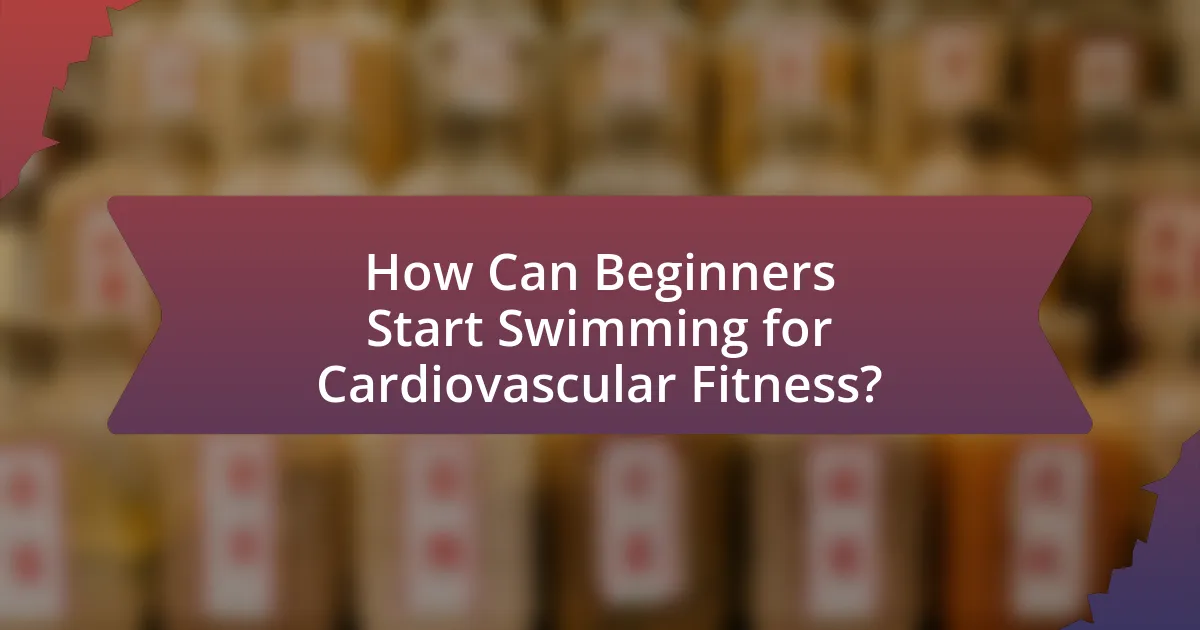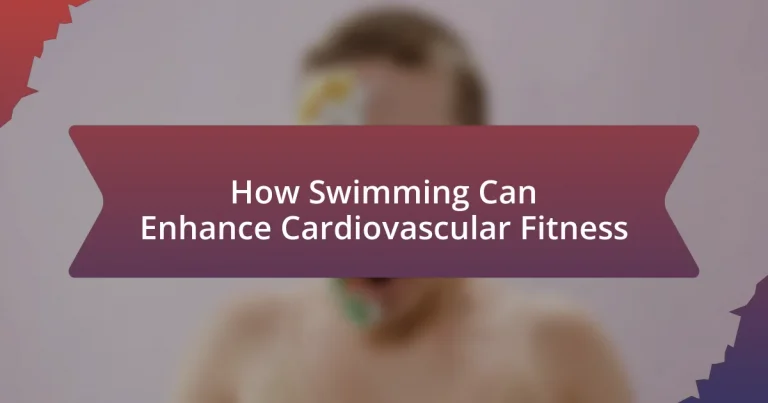Swimming is a highly effective exercise for enhancing cardiovascular fitness, providing a full-body workout that increases heart rate and improves circulation. The article explores how swimming induces physiological changes, such as improved cardiac output and oxygen consumption, leading to significant gains in aerobic capacity. It discusses the engagement of various muscle groups during different swimming strokes and the long-term benefits of regular swimming, including reduced risks of heart disease and improved blood pressure and cholesterol levels. Additionally, the article offers guidance for beginners on proper techniques, safety measures, and effective workout strategies to maximize cardiovascular health through swimming.

How Does Swimming Enhance Cardiovascular Fitness?
Swimming enhances cardiovascular fitness by providing a full-body workout that increases heart rate and improves circulation. The continuous movement against water resistance requires the heart to pump more efficiently, thereby strengthening the cardiovascular system. Research indicates that swimming can lead to significant improvements in aerobic capacity, with studies showing that regular swimming sessions can increase VO2 max, a key indicator of cardiovascular fitness. For instance, a study published in the Journal of Sports Medicine found that participants who swam regularly experienced a 10-30% increase in their aerobic capacity over a 12-week period. This evidence supports the conclusion that swimming is an effective exercise for enhancing cardiovascular health.
What physiological changes occur in the body during swimming?
Swimming induces several physiological changes in the body, primarily enhancing cardiovascular fitness. During swimming, the heart rate increases to supply more oxygen to the muscles, leading to improved cardiac output. This activity also stimulates the respiratory system, resulting in deeper and more efficient breathing patterns to meet the oxygen demands of the body. Additionally, swimming activates various muscle groups, promoting increased muscle strength and endurance. Research indicates that regular swimming can lead to lower resting heart rates and improved blood circulation, which are indicators of enhanced cardiovascular health.
How does swimming improve heart rate and circulation?
Swimming improves heart rate and circulation by providing a full-body workout that increases cardiovascular endurance. The continuous movement in water requires the heart to pump more blood to supply oxygen to the muscles, which elevates the heart rate. Research indicates that swimming can enhance cardiac output and improve vascular function, leading to better circulation. A study published in the Journal of Sports Sciences found that regular swimming significantly increases stroke volume and reduces resting heart rate, demonstrating its effectiveness in enhancing cardiovascular fitness.
What role does oxygen consumption play in swimming?
Oxygen consumption is crucial in swimming as it directly influences an athlete’s endurance and performance. During swimming, the body requires oxygen to produce energy through aerobic metabolism, which is essential for sustaining prolonged physical activity. Research indicates that trained swimmers can achieve higher maximal oxygen uptake (VO2 max) levels, which correlates with improved cardiovascular fitness and performance. For instance, a study published in the Journal of Sports Sciences found that elite swimmers have VO2 max values significantly higher than those of non-swimmers, demonstrating the importance of oxygen consumption in enhancing swimming efficiency and overall fitness.
Why is swimming considered a full-body workout?
Swimming is considered a full-body workout because it engages multiple muscle groups simultaneously, including the arms, legs, core, and back. This comprehensive engagement occurs as swimmers use various strokes, such as freestyle, breaststroke, and butterfly, which require coordination and strength from different parts of the body. Additionally, swimming promotes cardiovascular fitness by elevating heart rate and improving lung capacity, making it an effective aerobic exercise. Studies have shown that swimming can burn a significant number of calories, with vigorous swimming burning approximately 400-700 calories per hour, depending on the individual’s weight and intensity of the workout. This calorie expenditure further underscores swimming’s effectiveness as a full-body workout.
How do different swimming strokes affect cardiovascular fitness?
Different swimming strokes significantly impact cardiovascular fitness by varying the intensity and muscle engagement involved. For instance, freestyle swimming typically elevates heart rate more than breaststroke due to its continuous and fast-paced nature, promoting greater cardiovascular endurance. Research indicates that swimmers using the butterfly stroke experience increased cardiovascular demands, as it requires more energy and engages larger muscle groups, leading to improved aerobic capacity. A study published in the Journal of Sports Sciences found that swimmers who practiced multiple strokes showed enhanced cardiovascular fitness levels compared to those who specialized in one stroke, highlighting the benefits of stroke variety in training.
What muscles are engaged during swimming and how do they contribute to fitness?
Swimming engages multiple muscle groups, including the latissimus dorsi, pectorals, deltoids, triceps, quadriceps, hamstrings, and core muscles. These muscles contribute to fitness by enhancing strength, endurance, and flexibility, which are essential for overall cardiovascular health.
The latissimus dorsi and pectorals are primarily responsible for the pulling motion in strokes, improving upper body strength and promoting better posture. The deltoids and triceps assist in arm movements, contributing to shoulder stability and strength. The quadriceps and hamstrings engage during kicks, enhancing leg strength and propulsion in the water. Core muscles stabilize the body, improving balance and efficiency in swimming, which can lead to better cardiovascular performance.
Research indicates that swimming can significantly improve cardiovascular fitness, as it elevates heart rate and promotes aerobic capacity, making it an effective full-body workout.
What are the long-term benefits of swimming for cardiovascular health?
Swimming significantly improves cardiovascular health over the long term by enhancing heart efficiency and reducing the risk of heart disease. Regular swimming increases the heart’s stroke volume, allowing it to pump more blood with each beat, which leads to lower resting heart rates and improved circulation. Studies indicate that individuals who swim regularly have a 30-40% lower risk of cardiovascular-related mortality compared to sedentary individuals. Additionally, swimming helps in managing blood pressure and cholesterol levels, contributing to overall heart health. The American Heart Association recommends at least 150 minutes of moderate-intensity aerobic activity, such as swimming, per week to achieve these cardiovascular benefits.
How does regular swimming reduce the risk of heart disease?
Regular swimming reduces the risk of heart disease by improving cardiovascular fitness and promoting heart health. Engaging in swimming enhances blood circulation, lowers blood pressure, and helps maintain healthy cholesterol levels. Studies indicate that individuals who swim regularly experience a significant reduction in the risk of developing heart disease, with research showing that aerobic activities like swimming can lower the risk by up to 30-40%. Additionally, swimming helps manage weight, reduces stress, and improves overall physical fitness, all of which contribute to a healthier heart.
What impact does swimming have on blood pressure and cholesterol levels?
Swimming significantly lowers blood pressure and improves cholesterol levels. Regular swimming has been shown to enhance cardiovascular health by promoting vasodilation, which reduces blood pressure. A study published in the Journal of Clinical Hypertension found that individuals who engaged in regular swimming experienced a notable decrease in systolic and diastolic blood pressure. Additionally, swimming helps increase high-density lipoprotein (HDL) cholesterol while lowering low-density lipoprotein (LDL) cholesterol. Research from the American Heart Association indicates that aerobic exercises like swimming can lead to improved lipid profiles, contributing to overall heart health.

How Can Beginners Start Swimming for Cardiovascular Fitness?
Beginners can start swimming for cardiovascular fitness by incorporating structured swim sessions into their weekly routine, aiming for at least 150 minutes of moderate-intensity aerobic activity, as recommended by the American Heart Association. To begin, novices should focus on learning basic strokes, such as freestyle and breaststroke, which effectively engage multiple muscle groups and elevate heart rate.
Additionally, beginners should consider starting with shorter distances and gradually increasing their duration and intensity as their comfort and skill level improve. Research indicates that swimming can significantly enhance cardiovascular health, with a study published in the Journal of Sports Medicine showing that regular swimming can lower blood pressure and improve overall heart function.
What are the essential skills needed for effective swimming?
The essential skills needed for effective swimming include proper breathing techniques, stroke mechanics, body position, and endurance. Proper breathing techniques, such as rhythmic inhalation and exhalation, allow swimmers to maintain oxygen flow while minimizing drag. Stroke mechanics involve mastering different strokes, like freestyle and breaststroke, which enhance efficiency and speed in the water. Maintaining an optimal body position, such as a streamlined posture, reduces resistance and improves propulsion. Lastly, endurance is crucial, as it enables swimmers to sustain longer periods in the water, thereby enhancing cardiovascular fitness. Studies indicate that swimmers with well-developed endurance can perform better in competitive settings, demonstrating the importance of these skills in effective swimming.
How can beginners learn proper swimming techniques?
Beginners can learn proper swimming techniques by taking structured lessons from certified instructors, practicing regularly, and focusing on specific strokes. Structured lessons provide foundational knowledge and personalized feedback, which are essential for mastering techniques such as freestyle, breaststroke, backstroke, and butterfly. Regular practice reinforces muscle memory and builds confidence in the water. Research indicates that guided instruction significantly improves swimming efficiency and safety, as evidenced by a study published in the Journal of Sports Sciences, which found that participants who received professional coaching demonstrated a 30% improvement in stroke technique compared to those who practiced independently.
What safety measures should beginners take when starting to swim?
Beginners should take several safety measures when starting to swim, including swimming in designated areas with lifeguards present, using flotation devices if necessary, and ensuring they are comfortable in the water. Swimming in supervised locations reduces the risk of drowning, as lifeguards are trained to respond to emergencies. Additionally, using flotation devices can provide extra support for those who are not yet confident in their swimming abilities. It is also crucial for beginners to practice swimming with a buddy to enhance safety, as having someone nearby can assist in case of distress. These measures collectively help to create a safer swimming environment for newcomers.
What types of swimming workouts are best for cardiovascular fitness?
High-intensity interval training (HIIT) swimming workouts are best for cardiovascular fitness. These workouts involve alternating between short bursts of intense swimming and periods of rest or lower intensity, which effectively elevates heart rate and improves cardiovascular endurance. Research indicates that HIIT can lead to significant improvements in aerobic capacity and overall heart health, making it a highly effective method for enhancing cardiovascular fitness through swimming.
How can interval training be incorporated into swimming routines?
Interval training can be incorporated into swimming routines by alternating between high-intensity sprints and lower-intensity recovery periods. For example, swimmers can perform sets of 50 meters at maximum effort followed by 30 seconds of easy swimming or rest, repeating this cycle for a predetermined number of sets. Research indicates that this method effectively improves cardiovascular fitness and increases aerobic capacity, as evidenced by a study published in the Journal of Sports Science, which found that interval training enhances both VO2 max and overall swimming performance.
What is the recommended frequency and duration of swimming sessions?
The recommended frequency of swimming sessions is three to five times per week, with each session lasting between 30 to 60 minutes. This frequency and duration are supported by guidelines from organizations such as the American Heart Association, which emphasizes that regular aerobic exercise, including swimming, is essential for improving cardiovascular fitness. Engaging in swimming sessions within this range can effectively enhance heart health and overall fitness levels.
What Tips Can Enhance Swimming’s Impact on Cardiovascular Fitness?
To enhance swimming’s impact on cardiovascular fitness, swimmers should incorporate interval training, vary stroke techniques, and maintain consistent practice. Interval training, which involves alternating between high-intensity sprints and lower-intensity recovery periods, has been shown to improve cardiovascular endurance significantly. Research indicates that this method can increase aerobic capacity more effectively than steady-state swimming alone. Additionally, varying stroke techniques engages different muscle groups and promotes overall cardiovascular conditioning. Consistent practice, ideally three to five times a week, ensures sustained improvements in heart health and endurance, as regular aerobic exercise is linked to enhanced cardiovascular function.
How can swimmers track their cardiovascular progress?
Swimmers can track their cardiovascular progress by monitoring heart rate, swim times, and perceived exertion levels during training sessions. Heart rate monitors provide real-time data on cardiovascular response to exercise, allowing swimmers to assess their fitness levels and recovery times. Additionally, recording swim times for specific distances can indicate improvements in endurance and speed, which are key indicators of cardiovascular fitness. Studies show that consistent tracking of these metrics can lead to better training adjustments and enhanced performance outcomes.
What tools and technologies can assist in monitoring fitness levels?
Wearable fitness trackers, smartwatches, and mobile applications are essential tools and technologies that assist in monitoring fitness levels. These devices typically measure metrics such as heart rate, calories burned, distance traveled, and activity duration. For instance, devices like the Fitbit and Apple Watch provide real-time data and insights into cardiovascular performance, enabling users to track their progress over time. Research indicates that consistent use of these technologies can lead to improved fitness outcomes, as they encourage regular physical activity and provide feedback on performance metrics.
How can swimmers set realistic fitness goals?
Swimmers can set realistic fitness goals by assessing their current fitness level, defining specific and measurable objectives, and considering their training schedule. Evaluating current performance metrics, such as lap times and endurance, allows swimmers to establish a baseline. Setting SMART goals—Specific, Measurable, Achievable, Relevant, and Time-bound—ensures that objectives are clear and attainable. For example, a swimmer might aim to improve their 100-meter freestyle time by a specific number of seconds within a set timeframe. Additionally, incorporating feedback from coaches and tracking progress through regular assessments can help swimmers adjust their goals as needed, ensuring they remain realistic and aligned with their overall fitness journey.
What common mistakes should swimmers avoid to maximize benefits?
Swimmers should avoid poor technique, inadequate warm-up, and neglecting recovery to maximize benefits. Poor technique can lead to inefficient strokes, reducing the effectiveness of the workout and increasing the risk of injury. A study published in the Journal of Sports Sciences indicates that swimmers with proper technique can improve their performance by up to 20%. Inadequate warm-up can result in muscle strain and decreased performance; research shows that a proper warm-up enhances blood flow and prepares the body for exertion. Lastly, neglecting recovery can hinder progress, as muscles need time to repair and strengthen; the American College of Sports Medicine recommends incorporating rest days to optimize training outcomes.
How can improper technique hinder cardiovascular fitness gains?
Improper technique can significantly hinder cardiovascular fitness gains by causing inefficient movement patterns that reduce the effectiveness of aerobic exercise. When swimmers use incorrect form, such as poor stroke mechanics or inadequate breathing techniques, they expend more energy without maximizing oxygen uptake, leading to suboptimal cardiovascular conditioning. Research indicates that swimmers with proper technique can achieve higher intensity levels and longer durations in their workouts, which are crucial for improving cardiovascular fitness. For example, a study published in the Journal of Sports Sciences found that swimmers who maintained optimal stroke efficiency demonstrated a 15% increase in VO2 max compared to those with poor technique, highlighting the direct correlation between technique and cardiovascular performance.
What are the signs of overtraining in swimming?
The signs of overtraining in swimming include persistent fatigue, decreased performance, increased susceptibility to injuries, mood swings, and disrupted sleep patterns. These symptoms indicate that the swimmer’s body is not recovering adequately from training stress. Research shows that overtraining can lead to hormonal imbalances, such as elevated cortisol levels, which further exacerbate fatigue and hinder recovery. Additionally, swimmers may experience a decline in motivation and enjoyment of the sport, which are critical indicators of overtraining.





